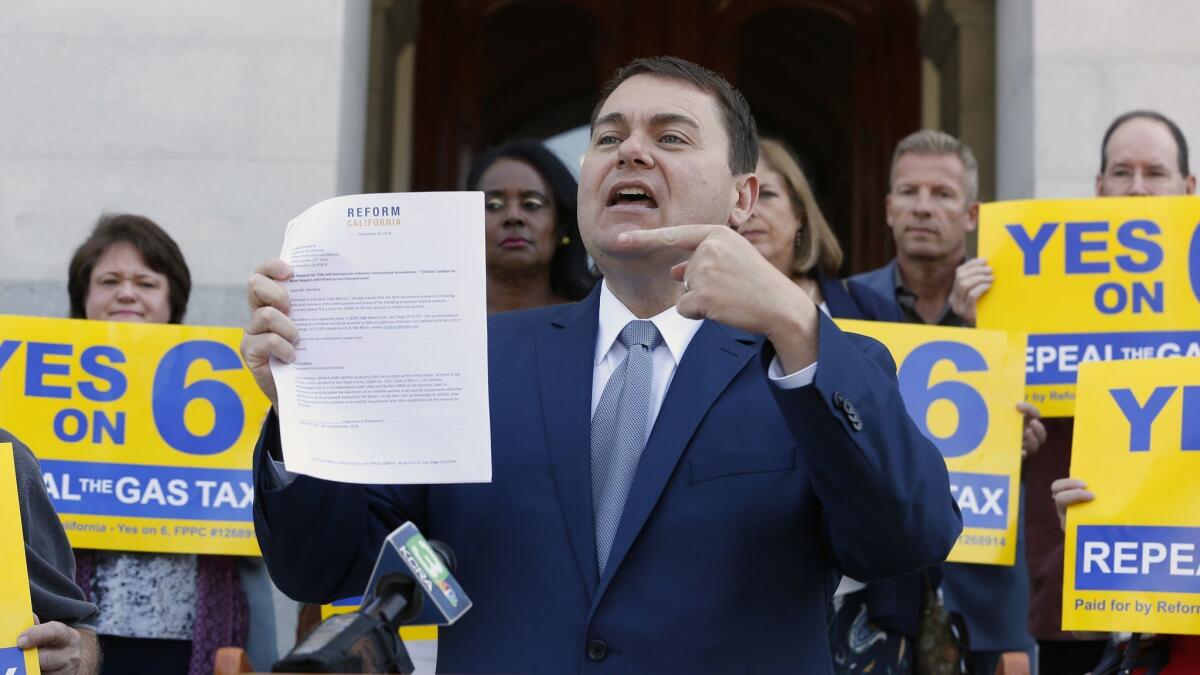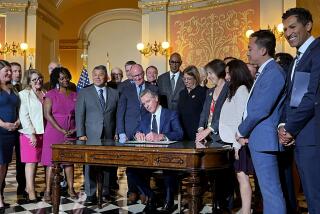Initiative to repeal gas tax hike sparks debate over how transportation funds are spent in California

Reporting from Sacramento ‚ÄĒ In urging California voters to repeal new fuel taxes, Republicans say the state already had enough money to repair roads but squandered it by diverting it to other state programs.
Legislative leaders deny that money from motorists has been misused. They say the law prohibits non-transportation projects from getting any of the more than $5-billion annual take from last year’s increase in gas and diesel taxes and vehicle fees.
The dispute has been a major focus of campaign ads and stump speeches by those pushing Proposition 6. Republican leaders have been pinning their hopes on voters being riled up by accusations that state officials have misspent gas tax funds.
‚ÄúI find it to be a problem when they take gas tax monies that should go to road repairs and they divert it to everything but road repairs,‚ÄĚ Proposition 6 campaign chairman Carl DeMaio said last week during a Sacramento debate with Matt Cate, the co-chairman of the campaign against the initiative.
Cate and Democratic elected officials dismiss DeMaio’s claims and say that a ballot measure approved in June further restricts the use of new fuel taxes and vehicle fees enacted as part of Senate Bill 1.
‚ÄúProponents of Proposition 6 are using a talking point that is equal parts brazen and baseless,‚ÄĚ Assembly Speaker Anthony Rendon (D-Paramount) said. ‚ÄúAfter voters overwhelmingly approved Proposition 69 in June, SB 1 funds cannot and will not be diverted from transportation purposes.‚ÄĚ
Rendon was among the state Democratic leaders who pushed through the legislation in April 2017 to raise the state gas tax by 12 cents a gallon, boost taxes on diesel fuel and create a new vehicle fee ranging from $25 to $175 annually, based on a car’s value.
Gov. Jerry Brown and legislative leaders said the new levies were necessary to address a $130-billion backlog in road and bridge repairs caused in part by the fact that the Legislature had not increased the gas tax in 23 years.
The first full year of new funding, in the fiscal year that began July 1, is expected to generate nearly $4.4 billion in revenue.
Most of the money will be set aside for improving roads and bridges. But 22% ‚ÄĒ nearly $1 billion in the first full year ‚ÄĒ will go to a broad mix of other projects, including mass transit, intercity rail, and bike and pedestrian paths. Transit and rail programs are covered by vehicle fees.
Other funds will go toward job training and administrative services for state transportation agencies.
In qualifying the repeal measure for the Nov. 6 ballot, DeMaio and Republican leaders have been especially critical of how the state has shifted funds to cover debt payments on Proposition 1B, a $19-billion transportation bond measure passed by California voters in 2006.
Voters agreed with arguments from then-Republican Gov. Arnold Schwarzenegger and former state Senate leader Don Perata (D-Oakland), who said the bonds would ‚Äúmake a real difference to the lives of millions of Californians, who will find it easier to get to work.‚ÄĚ
Although most of the measure’s money went to improving highways, the bond projects also included $40 million to expand railroad tracks used by Burlington Northern Santa Fe Railway Co. over Tehachapi Pass and to help eliminate a bottleneck in Colton that delayed Union Pacific and BNSF trains.
Some public officials objected at the time to using public bond funds to help private railroad companies, saying the voters who approved the bonds intended them to fix roads. State transportation officials said the rail projects helped California’s economy by improving the flow of goods.
Those transportation bond payments were covered at first by the state’s general fund, which also pays for most other public programs, including schools, prisons, public safety and social services.
But in 2007, the state began using money from fuel taxes for the more than $1 billion in debt service on the bonds, freeing up that amount in the general fund for other programs.
The state stopped that practice in 2010 and instead began using truck weight fees to service the Proposition 1B debt. Before those shifts, the weight fees and fuel excise taxes went into the State Highway Account, which paid for state highway rehabilitation projects and maintenance.
Fuel taxes in place before SB 1 continue to go into that fund, but the new tax revenue goes to new, restricted accounts, including one for road maintenance and rehabilitation.
Last year, the debt service on the Proposition 1B bonds included $499.6 million in principal, $795 million in interest and $481,000 in fees. Since 2010, the state has paid $4.9 billion in interest on the bonds.
The use of gas tax money and then truck weight fees to pay debt service drew objections from state Sen. John Moorlach (R-Costa Mesa), an accountant who previously served as Orange County treasurer and tax collector.
Money ‚Äúshould have come out of the general fund to pay the debt,‚ÄĚ he said. ‚ÄúIt‚Äôs a little bookkeeping shuffle. Now the state is coming and saying, ‚ÄėOh geez, we need to fix roads.‚Äô Well you had the money to fix roads. You just allocated them to somewhere else.‚ÄĚ
Sen. Jim Beall (D-San Jose), chairman of the state Senate Transportation and Housing Committee, defended using truck weight fees to pay bond debt.
‚ÄúThe money is actually going to transportation projects,‚ÄĚ Beall said of the bond debt. ‚ÄúThe advantages far exceed the interest cost by repairing the roads quicker and getting them done before they start falling apart even worse. It‚Äôs cheaper to do it with bonds.‚ÄĚ
Proposition 6 supporters have also noted that for the last nine years, the state Department of Motor Vehicles has transferred money to the general fund ‚ÄĒ $89 million in the current budget ‚ÄĒ from processing fees charged to insurance companies and others for requesting driver information.
H.D. Palmer, spokesman for the state Finance Department, said that money has ‚Äúnever been considered to be vehicle revenues.‚ÄĚ
From 2013 to 2015, the state also loaned the high-speed rail project $54 million from a transportation account funded by the sales tax on diesel fuel. The loan has not yet been repaid, officials said.
DeMaio has also criticized the use of $34 million from the State Highway Account over the last five years for a program that creates bike lanes and pedestrian walkways and makes sidewalks accessible to the disabled.
He says that fuel fees should go only to roads and that bike and pedestrian lanes should be funded by the tax on car sales.
‚ÄúThere is great frustration when people find that there is no money for potholes, but we are removing lanes to do these dedicated bike lanes,‚ÄĚ DeMaio said. ‚ÄúWe believe bike lanes should be additive, not subtractive. It shouldn‚Äôt be an either-or; it should be a both.‚ÄĚ
But the state has proposed spending $1 billion of SB 1 money over the next 10 years on such projects, and on providing sidewalk improvements and safe routes to schools.
‚ÄúThey are part of the transportation system,‚ÄĚ Beall said. ‚ÄúIt‚Äôs not a significant amount, but if we can get more people to use bicycle paths and that kind of transportation, it helps everybody.‚ÄĚ
The official name of SB 1, the Road Repair and Accountability Act, is misleading, said Assemblyman Vince Fong (R-Bakersfield), vice chairman of the Assembly Transportation Committee.
Because the new law was pitched largely as funding for road repairs, ‚ÄúCalifornians are going to be upset, and they should be upset,‚ÄĚ when hundreds of millions of dollars instead go to other programs, Fong said.
Beall said supporters of SB 1 were clear throughout the debate that the measure would fund transportation needs besides roads, including mass transit.
‚ÄúThe transit does get cars off the road. That‚Äôs why we do it,‚ÄĚ Beall said. ‚ÄúIt‚Äôs a wise investment.‚ÄĚ
State Senate leader Toni Atkins (D-San Diego) said all spending under SB 1 has been restricted by the California Constitution.
The document says all taxes on fuels for motor vehicles used on public roads can be used only for ‚Äúresearch, planning, construction, improvement, maintenance, and operation of public streets and highways [and their related public facilities for nonmotorized traffic]‚ÄĚ as well as the same purposes for mass transit.
‚ÄúNo gas tax money has been used for purposes other than those explicitly allowed,‚ÄĚ Atkins said.
But Proposition 6 backers say the definition of what constitutes allowable transportation spending is too broad under the Constitution, and they have proposed a 2020 ballot measure to dedicate all fuel tax money to road and bridge projects.
In criticizing the current definition as too broad, initiative backers note that new transportation revenue also includes up to $50 million during the next decade for local governments to provide job training to people, including those just out of prison, so they can work on transportation projects.
About $79 million a year in tax money from gas pumped into off-road vehicles and boats will go to the general fund for state parks department programs during the next decade, while $26 million a year in gas and diesel taxes for farm equipment, including tractors, will go to the state Department of Food and Agriculture.
‚ÄúWhen you look at the debate on SB 1, there is a significant amount of money that isn‚Äôt for road projects ‚ÄĒ that goes to parks, that goes to labor programs, that goes to non-road infrastructure,‚ÄĚ Fong said.
The agriculture agency will use the fuel taxes it gets to pay for inspections and keeping produce-harming pests from the state through point-of-entry terminals. Parks officials said fuel tax money from off-road vehicles will be spent on programs including increased law enforcement, environmental monitoring and maintenance.
Another $70 million is pegged to go to state universities during the next decade for transportation research.
Atkins defended the existing spending plan.
‚ÄúNothing in Senate Bill 1, or its companion constitutional amendment approved by the voters in June of 2018, changed the limited uses of gas tax revenues,‚ÄĚ she said.
Coverage of California politics ¬Ľ
Twitter: @mcgreevy99
More to Read
Get the L.A. Times Politics newsletter
Deeply reported insights into legislation, politics and policy from Sacramento, Washington and beyond. In your inbox three times per week.
You may occasionally receive promotional content from the Los Angeles Times.











